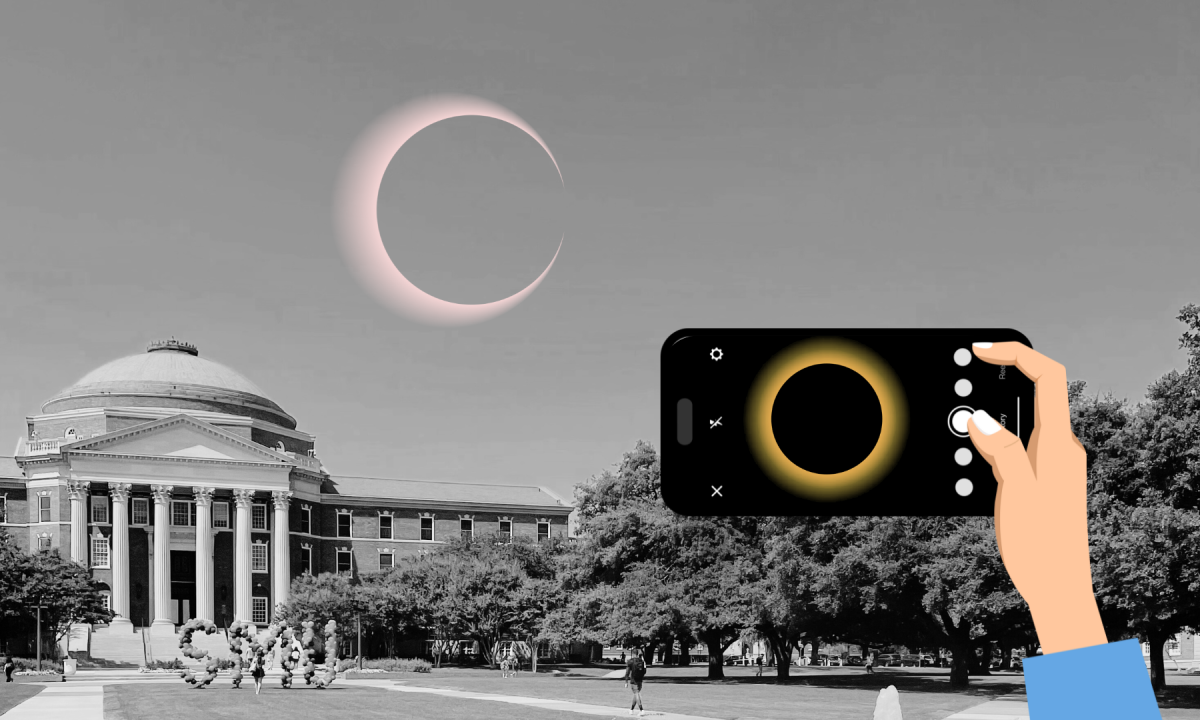The 2024 total solar eclipse is coming to Dallas on April 8 and the event has already gained global traction. People from all over the world are traveling to Texas, as cities like Dallas and Austin are in its path of totality.
With the eclipse gaining so much attention, the question everyone is asking is, “How do I take a photograph of the eclipse?”
SMU Film and Media Arts professor Rebecca Flores has the answer.
“Whether it’s your phone or another camera, any camera is going to work as long as you shoot with a solar filter,” Flores said.
Regardless of the type of camera you have, there are some tricks people should know before taking pictures of the eclipse. Not everyone has a professional camera, so this camera guide is centered around the use of smartphone cameras.
Here’s a guide on how to take a picture of the eclipse with a smartphone:
1. Before the Eclipse
Filters! Filters! Filters!
Protecting your eyes during the eclipse is crucial and the same goes for protecting your camera lens. Without a solar filter, you risk damaging your camera lens. SMU physics professor, Joel Meyers, explained how the eclipse can damage a camera lens if not protected properly.
“Like our eyes, the sensor in a camera tends to be very sensitive to intense radiation,” Meyers said. “If we look right up at the sun, we can go partially blind and can damage our retinas. With a camera, it’s the same thing.”
Professor Flores further explains how the sun can burn your camera sensors without the use of a solar filter.
“The inside of your camera has a sensor that collects light to create an image,” Flores said. “If you shoot directly at the sun and let too much light hit that sensor, it’s going to burn a circle into your sensor and completely damage the camera. You would either have to replace the sensor or replace the whole camera.”
The American Astronomical Society also strongly advises the use of a solar filter, “at any time other than during totality.” There are several solar eclipse smartphone filters available on Amazon and at local camera stores.
What if you don’t want to buy a solar filter for your phone?
“If you don’t have custom solar filters for your phone camera, you can use eclipse glasses,” Meyers said.
Use a tripod
The best way to take photos of the eclipse is to keep your camera as steady as possible. To achieve a steady camera frame, use a tripod. When people film with their hands, the video often comes out shaky. A tripod will help keep your smartphone stable during the eclipse. It also allows you to be hands-free so you can be in your eclipse video with friends, capturing the silhouettes of everyone enjoying totality.
Position the tripod so that it faces the direction of the eclipse, set up your phone, and start filming. Solar eclipse photographer and author of How to Photograph the Solar Eclipse, Alan Dyer, in an interview with Space.com explains the tripod use best.
“Put it in wide-angle mode, start the movie going a couple of minutes before totality, and just let it run,” Dyer said.
Practice on the moon before the eclipse hits
Practice makes perfect. To get the perfect picture of the eclipse, NASA suggests practicing on “the full moon to get an idea of how large the sun-in-eclipse will appear with your smartphone lens.”
Taking pictures of the moon on a smartphone is tricky because the phone camera automatically adjusts the exposure, making the moon overexposed with no details in the dark. To avoid this, manually adjust the exposure with your finger on the camera app. This is challenging, hence why NASA suggests practicing a few days before.
2. Phone Settings for Eclipse
Turn off the flash before totality hits!
“Turn off the flash, you don’t need it,” said Robert Hart, SMU photojournalism professor.
When the eclipse hits totality, the sky will turn pitch-black and resemble nighttime. One might think flash will be useful in the dark, but using flash is the wrong way to go.
During totality, if you’re going to have something in the foreground, like Dallas Hall, you don’t want it to get blasted by flash. Shooting with flash during totality will produce photos with white light. It makes the photo look unnatural and grainy.
Not only does flash make your photography worse but “it will detract from the experience of totality for everyone around you,” Jamie Carter, a science and technology contributor for Space.com said.
Do not zoom in
For the eclipse, do not zoom in. According to Carter, “pinching the screen to zoom in on the solar eclipse will lower image resolution.” When you zoom in, you lose resolution and it reduces the quality of the image, resulting in a grainy photo.
Brightness
Flores mentioned the one thing to pay attention to is the brightness of photos. For iPhone users, when you open the camera app, there is an option to manually brighten or darken a photo – this is called exposure. By manually adjusting the brightness, you can set the exposure while shooting the eclipse.
Flores suggests using a lower exposure for the eclipse. When you use low exposure, it makes specific details more defined that you wouldn’t be able to see with a high exposure.
“You’re going to have to lower the exposure to see more detailing in the sun,” Flores said.
Don’t count on auto-focus
During the eclipse, if you let your phone camera use auto-focus, this makes the camera focus on anything and everything other than the eclipse. To keep the camera focused on the eclipse, use manual focus or “focus lock” to keep the camera focused on the eclipse. When the focus lock appears, set the focus to infinity.
Most phones have this option. For iPhones, hold down on your subject until the “AE/AF” indicator shows up. Depending on the type of iPhone you have, there are iPhone camera apps that can help set camera focus to infinity if it’s not an option in the camera app. Android cameras have the focus set to infinity built in and don’t need an additional app.
Use Burst Mode
Burst mode allows you to take multiple pictures at once. One moment during the eclipse you’ll want to capture is the “diamond ring”. This is the last bit of sunlight before totality hits, making everything completely dark. Be sure to act fast, as the diamond ring happens in seconds and can be missed if people aren’t paying attention.
By using burst mode, you can watch the diamond ring happen in real-time and not have to worry about taking a picture.
3. During the Eclipse
What to do During Totality
Once it hits totality, take off the solar filters! Totality happens when the moon completely covers the sun, turning everything into darkness. At this point, camera filters can be removed and pictures can be taken of the eclipse safely. You can keep filters on during totality, but solar filters will make the coloring of the sun look different.
“We’re used to seeing the sun being orange,” Flores said. “A lot of solar filters make the Sun look a different color. It might look blue or even purple.”
Once totality is over, put solar filters back on your cameras otherwise you risk damaging them.
Take a second to watch the eclipse
Remember to take the time and watch the eclipse with your own eyes. Getting the opportunity to watch the total solar eclipse’s path of totality in front of your eyes is a once-in-a-lifetime moment. Don’t get caught up in trying to take the “perfect” picture.
If you are going to focus on getting the “perfect picture,” focus on what’s happening around you.
“The most important thing is to focus on the people and what’s going on around you,” Hart said. “Photograph the people and have the eclipse in the background.”










